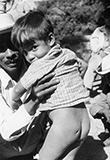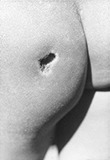Hesperian Health Guides
Using Medicines Safely and Effectively
HealthWiki > Disabled Village Children > Chapter 3: Prevention of Disabilities > The Need for More Sensible and Limited Use of Injections

Some medicines, when used correctly and given in safe conditions, are of great importance to health. These include vaccines that prevent illness and antibiotics for treating infections. But the incorrect use of medicines is a major cause of health problems and disabilities in the world.
Sometimes medicines are given when they are not needed or are not safe to use. And sometimes when medicines are needed, they may not be given in the safest way.
Contents
Is medicine needed and safe to use?
All over the world, in high- and low-resource countries, medicines are given when they are not needed. For example, antibiotics are given to cure problems they do not work against, such as viruses. Or medicines are given when they are not safe to use, as in pregnancy when they can harm a developing baby (see p.119). Before giving or using a medicine, think about whether the illness can get better without medicine, if a different medicine will work better, and if the benefits of using medicine are greater than the risks.
Is an injection needed?
When medicine is needed, it may not be given in the best way. Injections are often used when giving a medicine by mouth would be safer and as effective. People may demand injections because they believe injections work better or faster than medicines by mouth. Providers may overuse injections because they can charge more or because patients demand them. This creates a cycle in which people demand injections because doctors and health workers often use them, and doctors and health workers use them too often because people demand them.

Can an injection be given safely?
 |
 |
This child was injected with a needle that was not sterilized. This caused an infected abscess (pocket of pus) that burst. The child had been treated for a cold. It would have been better to give him no medicine at all. |
When an injection of medicine is necessary to treat an illness, needles and syringes must be sterile. This means germs that cause infections have been killed. Giving injections with needles or syringes that are not sterile can spread germs and cause serious infections such as HIV and hepatitis (see Where There Is No Doctor, pages 399 to 401, and 172). Unsterilized needles and syringes can also cause infections that lead to paralysis or spinal cord injury (see the story The Story of Jésica), or death. A needle or syringe must never be used to inject more than one person without first sterilizing it again.
Reusable syringes and disposable syringes
Some syringes can be used again and again because they can be taken apart for cleaning and are made of materials that can be sterilized. Reusable syringes must be cleaned and sterilized after every use (see Where There Is No Doctor, page 74).
Most syringes and needles come in sterile packages and are made to be used only once. They cannot be sterilized again. Disposable syringes can be disinfected and reused, but we do not recommend doing this because a syringe that has only been disinfected and not sterilized can still spread infections, including hepatitis and HIV. This should be done only when it is necessary to save someone’s life.
| How to wash and disinfect a disposable syringe and needle: To most safely reuse a disposable syringe, wash and disinfect it right after using it and again right before you reuse it. Disinfecting a syringe makes it less likely to spread infection, but does not prevent it completely. 
|
Using medicines and injections safely and effectively is as important to health as vaccination, clean water, or the correct use of latrines. Health workers, school teachers, and community organizers can all work to help people weigh the possible risks and benefits of using any medication. For ideas on teaching about the danger of unnecessary medicines and injections, see Helping Health Workers Learn, Chapters 18, 19, and 27.


